Horizontal Sliding Fire Doors: Architectural Design Freedom
Knowing the New Code
During most of the past century, the use of horizontal sliding fire doors was limited. They could not, for instance, be used as the primary means of egress, and, when used to separate internal spaces, they were required to meet stringent fire-resistant requirements. But early models, developed for acoustical purposes, equipped with a two-track folding partition system encasing a dead air space, were also capable of resisting fire.
In 1977, sliding door systems passed two UL tests for door assemblies and were shown to withstand intense temperatures rising to 1,700 degrees Fahrenheit. Later, the National Fire Protection Association (NFPA), which develops, publishes, and disseminates more than 300 consensus codes and standards involving life safety features such as sprinklers and alarms, exits, windows, and doors, permitted the use of sliding fire doors as a means of egress in selected applications. These included protecting elevator lobbies in buildings where the occupant loads were less than 50 and as fire and smoke barriers in health-care facilities. Published in the 1988 edition of the Life Safety Code, the new standards were adopted by the then existing three regional model building groups. These were the:
- Southern Building Code Congress International, which covered the southern and Gulf states and produced the Standard Building Code
- Building Officials and Code Administration, which covered the Northeast and Midwest and produced the National Building Code
- International Conference of Building Officials, which covered California and the West and produced the Uniform Building Code
In 2000, the three groups merged and produced a single national building code, the International Building Code (IBC). At approximately the same time, horizontal sliding doors were approved as an acceptable means of egress in all applications, regardless of occupancy loads, except for applications known as Category H applying to storage of flammable and toxic materials. The NFPA adopted the changes so that, in effect, both the IBC and NFPA contain the same requirements regarding sliding fire doors.
The IBC Code Section 1010.1.2 states, “Egress doors shall be side hinged swinging.” But exception #6 (in the 2015 version) reads, “In other than Group H occupancies, special-purpose horizontal sliding, accordion, or folding door assemblies complying with Section 1010.1.4.3.”
The 2015 NFPA 101 Life Safety Code accredited by the American National Standards Institute (ANSI) states:
7.2.1.14 Special-Purpose Horizontally Sliding Accordion or Folding Door Assemblies shall be permitted in means of egress, provided that all of the following criteria are met:
- The door is readily operable from either side without special knowledge or effort.
- The force that, when applied to the operating device in the direction of egress, is required to operate the door is not more than 67 N (Newton) (15 lbf [pound force]).
- The force required to operate the door in the direction of door travel is not more than 133 N (30 lbf) to set the door in motion and is not more than 67 N (15 lbf) to close the door or open it to the minimum required width.
- The door is operable using a force of not more than 222 N (50 lbf) when a force of 1100 N (250 lbf) is applied perpendicularly to the door adjacent to the operating device, unless the door is an existing horizontal sliding exit access door serving an area with an occupant load of fewer than 50.
- The door assembly complies with the fire protection rating, if required, and, where rated, is self-closing or automatic-closing by means of smoke detection in accordance with 7.2.1.8 and is installed in accordance with NFPA 80, Standard for Fire Doors and Other Opening Protectives.
The driving force behind the changes was the recognition that the horizontal accordion-type sliding door is a significant improvement over traditional swinging doors for the evacuation of people and has had a major impact on building safety and design. The general acceptance of Universal Design, which promotes design that is accessible for all regardless of ability or disability, plus the passing of ADA in 1990, further reinforced the acceptance of sliding doors for both fire and egress requirements. “Gaining acceptance for this fire door technology required not only that the products prove to be as effective as swinging doors for both ambulatory and non-ambulatory individuals, but it had to perform better, and this has been proven over four decades,” says Scott Smart, president of Won-Door based in Salt Lake City, Utah.
Unlike traditional vertical rolling assemblies where exposed parts are susceptible to damage caused by material handling equipment or abuse by building occupants, horizontal sliding door systems with completely concealed parts are virtually trouble free. Moreover, sliding door systems equipped with integrated microprocessor technology that continuously monitors all door functions enables the system to automatically reset itself following power bumps or building alarms. An industry-wide survey by FM Global, a leading commercial insurance company, found that nearly 80 percent of all conventional fire doors failed because of improper resetting or obstacles that prevented the door from closing.

Image courtesy Won-Door Corporation
Conclusion
Clearly, horizontal sliding self-closing door assemblies are an effective way to fulfill means-of-egress and life-safety requirements across the spectrum of building types. They are also a catalyst for architectural versatility, as more design professionals appreciate the possibilities resulting from revised codes. Smart adds, “This technology is unique in its ability to adapt to almost any opening size or configuration while still meeting the strict fire and egress requirements, and that is truly architectural freedom.”

|
Won-Door™ FireGuard products are specified worldwide in all types of commercial construction projects. Won-Door Corporation makes the most technologically advanced horizontal sliding fire door products in the building construction industry. The FireGuard system is fire-rated for up to 3 hours and meets all egress requirements found in the IBC and NFPA. www.wondoor.com |








